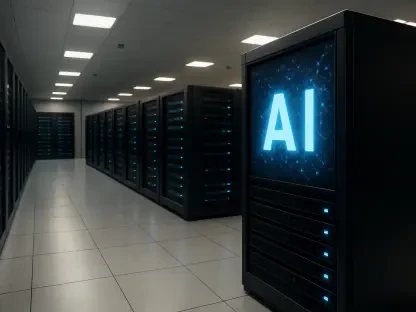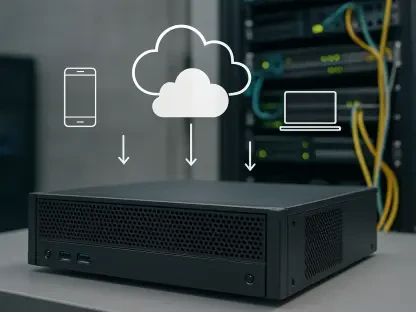With the widespread adoption of remote and hybrid work models, enterprises face an evolving cybersecurity landscape that demands modernized solutions. Traditional security measures such as firewalls are proving inadequate in the face of sophisticated cyber threats. The integration of Artificial Intelligence (AI) with Zero Trust principles emerges as a comprehensive strategy to safeguard business operations. This powerful combination addresses the current digital landscapes’ complexities, where verifying each access request rigorously becomes crucial.
Evolving Cybersecurity Needs
The inadequacy of traditional security measures has become evident as cyber threats grow more sophisticated and unpredictable. Firewalls and fixed access policies, which once sufficed, now fall short in countering dynamic and advanced attacks. These measures rely on predefined rules and static defenses, making them vulnerable to evasion techniques employed by modern cyber adversaries. As enterprises increasingly adopt cloud technologies and remote working environments, the need for a more adaptive and robust security approach becomes imperative.
Introducing AI and Zero Trust methodologies offers a promising solution. AI enhances threat detection and response capabilities through machine learning and automation. By analyzing vast amounts of data in real time, AI can identify anomalies and potential threats that may go unnoticed by traditional systems. Zero Trust, on the other hand, operates on the principle of ‘never trust, always verify,’ ensuring that each access request is scrutinized before granting entry. Together, these technologies form a formidable defense, shifting the security paradigm from a perimeter-based approach to one centered on safeguarding specific assets and data.
Synergy Between AI and Zero Trust
AI’s role in cybersecurity significantly complements Zero Trust principles by enabling continuous user authentication and adaptive security policies. Continuous authentication, powered by AI, ensures that users are constantly verified throughout their sessions. This approach mitigates the risks associated with compromised credentials, as any suspicious behavior triggers additional verification steps or restrictions. AI-driven systems learn and adapt to user behavior patterns, making it challenging for unauthorized actors to mimic legitimate activities.
Practical applications of AI in real-time threat response further bolster Zero Trust security. AI can analyze network traffic and user behaviors, identifying deviations that may indicate security breaches. This proactive stance allows for immediate and precise responses to threats, minimizing their impact. Zero Trust’s granular access control complements AI’s capabilities by limiting user privileges to the minimum required for their roles. This stringent control reduces the attack surface, preventing lateral movement within the network. The combination of AI and Zero Trust ensures a robust security framework capable of adapting to evolving threats while maintaining stringent access controls.
Addressing Remote Work Challenges
The rise of remote and hybrid work environments has amplified cybersecurity risks, necessitating advanced threat detection measures. Remote work often blurs the boundaries between personal and professional device usage, increasing the likelihood of security breaches. AI-driven threat detection is crucial in this context, as it continuously monitors user activities and network traffic, identifying potential threats regardless of the work environment. By leveraging machine learning algorithms, AI systems can recognize patterns indicative of malicious behavior, enabling timely interventions.
AI’s ability to provide real-time insights into network activities is invaluable for remote work setups. It allows security teams to detect anomalies and potential threats promptly, even when employees access enterprise resources from various locations. This continuous monitoring ensures that security measures remain effective, adapting to changes in user behavior and network conditions. Integrating AI with Zero Trust principles enhances security by focusing not only on external threats but also on internal vulnerabilities that may arise from compromised devices or credentials.
Implementing AI and Zero Trust
Integrating AI with Zero Trust requires a systematic approach, beginning with adopting a shared responsibility model. Organizations must prioritize data classification and establish robust governance structures to ensure that sensitive information remains secure. Data classification enables organizations to categorize information based on its sensitivity, ensuring that appropriate security measures are applied. Governance structures provide a framework for implementing and enforcing security policies, ensuring compliance and accountability.
A security-first culture is essential for the successful integration of AI and Zero Trust. Employee training and continuous learning are vital to addressing AI-specific risks and fostering a security-conscious workforce. Regular training sessions educate employees on recognizing phishing attempts, reporting suspicious activities, and adhering to security protocols. Continuous learning ensures that employees stay informed about the latest threats and best practices, adapting their behavior to mitigate risks effectively. By fostering a culture of vigilance, organizations can enhance their overall security posture and reduce the likelihood of successful cyber attacks.
Overcoming Integration Challenges
Integrating AI and Zero Trust into existing systems presents challenges, notably legacy system compatibility and keeping pace with AI advancements. Legacy systems often lack the flexibility to support modern security solutions, requiring significant upgrades or replacements. Organizations must assess their infrastructure and invest in updates to ensure seamless integration. Staying current with evolving AI technologies is equally important, as new advancements bring enhanced capabilities and improved threat detection. Regular updates and continuous investment in AI research and development are necessary to maintain a robust security framework.
Despite these challenges, the benefits of integrating AI and Zero Trust are substantial. Enhanced adaptive security policies allow organizations to respond dynamically to emerging threats, ensuring that security measures remain effective in the face of evolving tactics. Real-time threat intelligence provides immediate insights into potential breaches, enabling prompt and precise responses. The combination of AI and Zero Trust not only strengthens defenses but also streamlines security processes, reducing the burden on security teams and improving overall efficiency. By embracing this integrated approach, organizations can build resilient, proactive security infrastructures capable of withstanding modern cyber threats.
Proactive Adoption for Modern Security
With the widespread adoption of remote and hybrid work models, enterprises find themselves navigating an evolving cybersecurity landscape that requires modernized solutions. Traditional security measures, like firewalls, are becoming increasingly inadequate against today’s sophisticated cyber threats. As a result, integrating Artificial Intelligence (AI) with Zero Trust principles has emerged as a comprehensive strategy to protect business operations. This powerful combination is designed to address the complexities of the current digital landscape by rigorously verifying each access request. Here, each user and device is continuously authenticated and authorized, ensuring a higher level of security. Enterprises must adapt to this proactive approach, focusing on stricter access controls and real-time threat detection. As the nature of cyber threats continues to advance, relying solely on conventional methods is no longer sufficient. Embracing AI-driven security measures alongside Zero Trust frameworks is crucial for safeguarding sensitive data and ensuring operational continuity in this new era of work.









